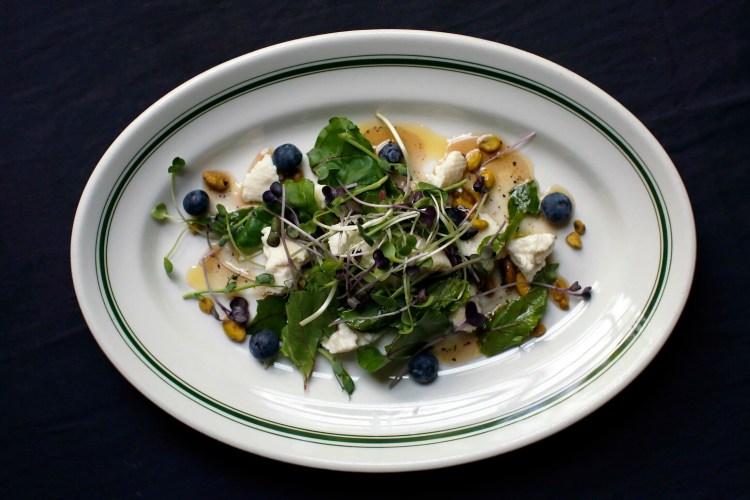Goat cheese in Maine is all over the map. Literally. Figuratively. And culinarily.
At last count, there were 34 members of the Maine Cheese Guild who make, mould and sell chevre, the enveloping French term for all goat cheese: fresh, soft-ripened, ashed and aged.
As both a confirmed turophile and committed locavore, I’ve sampled over half of the cheese on the guild’s goat list and have tasted, I believe, at least a half-dozen more from makers not yet on that list. I don’t hide my gluttony for cheese. But beyond my personal obsessions, let me also make the argument here that buying local goat cheese helps feed Maine’s food economy.

It’s easy to make goat cheese at home from fresh local goat’s milk. After the curds form, gather them in a cheesecloth and suspend them to let the whey drip away. (Keep the whey for baking and cooking.) Ben McCanna/Staff Photographer
For local farmers, setting up a goat dairy operation represents a relatively low bar for entry into the cheese-making world because goats are efficient milk producers and avid foragers who happily munch on a wide variety of plants that cows won’t eat. From an economic perspective, cheese is a value-added product, in other words it brings in more income than selling the goat’s milk would. And fresh goat cheese is relatively easy to make. The milk is heated up, mixed with cultures and rennet, set aside to separate curds from whey, dusted with salt, and allowed to sit some more until it’s ready to be sold.
Being green in Maine means buying local, fresh goat cheese.
Jon and Christelle McKee of Copper Tail Farm in Waldoboro have a 40-strong herd of Nubian and Nigerian dwarf dairy goats. From May to November, depending on when the goats have their kids, the couple milk the animals twice a day by hand, as they have for over six years now.
The McKees use goat’s milk to make yogurt, cajeta (caramel sauce) and soap. But the Friday I visited Jon at the Brunswick Farmers’ Market, most people were buying his fresh cheese, which he sells plain; mixed with garlic, herbs or lemon curd; and marinated in olive oil with rosemary and orange, or with lime and Aleppo pepper.
“What the goats eat, the quality of their feed, affects the final taste of the product,” Jon said, explaining that goats prefer to forage for saplings, raspberry bushes and even poison ivy than to dine on grass in a pasture. They’ll also eat hay, but feeding goats hay raises a farmer’s costs, so McKee’ prefers to let his goats forage.
Jean Koons, who owns and operates Kennebec Cheesery in Sidney with her husband, Peter, says the flavor of her cheese remains constant over the season because the goats’ foraging and grain diet remains relatively consistent. But she does notice a change in the texture of the chevre in the fall. It becomes creamier then, she said, because of naturally higher butterfat and protein levels in the milk. In summer, Koons likes to stuff zucchini blossoms with fresh chevre. She also makes a goat feta cheese, which she uses to replace fresh mozzarella in a caprese-like salad with tomatoes and basil.
At Appleton Creamery in Appleton, cheesemaker Caitlin Hunter makes several kinds of cheese from mostly Alpine goats’ milk, including chevre, feta, camembert-style, aged bloomy rinds and manchego-style. Her cheeses taste consistent throughout the milking season, she said, because the goats eat grains every day, as well as a steady diet of local, high-quality, second-cut hay.
“There is nothing like the first chevre of the spring, light and lemony,” Hunter said. Bloomy rinds spread perfectly on crackers after three weeks of aging. Appleton Creamery’s manchego (“Mainechegoat”) is best after three months when it is sharp and easy to grate, she continued, while its barrel-aged feta is aged for a year to produce the optimal dense, complex qualities.
When Hunter starts to rattle off pairings for her summer fresh chevre, her list seems even longer than the number of goat cheese makers in Maine. There is the classic beet partnership, of course. But she also suggests mushroom caps stuffed with herb and garlic chevre; tomatoes and lime pepper chevre; and new potatoes and dill chevre.
“Why stop with vegetables? This week at market, I’m going to sample fresh plain chevre with strawberries and mint,” Hunter said. Thus proving my point: goat cheese is all over the map in Maine — and that’s a good thing.
Christine Burns Rudalevige is a food writer, recipe developer, tester and cooking teacher in Brunswick, and the author of “Green Plate Special,” a cookbook from Islandport based on these columns. She can be contacted at:
Goat Cheese and Blueberry Salad
British food writer Diana Henry makes a version of this salad with goat cheese she makes herself. Given that I can get good local goat cheese from over 40 Maine farmers, I don’t have to make my own.
Serves 4
2 tablespoons nutty oil, such as hazelnut or walnut
2 tablespoons extra-virgin olive oil
1 tablespoon fruity vinegar, such as raspberry
½ teaspoon honey
Salt and pepper
1 ½ cups microgreens
1 cup fresh blueberries
4 ounces fresh goat cheese, crumbled
¼ cup pistachios, or toasted hazelnuts or almonds, coarsely chopped
Whisk together the oils, vinegar and honey in a large bowl. Season the vinaigrette with salt and pepper. Add the greens, berries, cheese and nuts. Toss lightly and serve immediately.
Send questions/comments to the editors.


